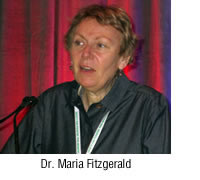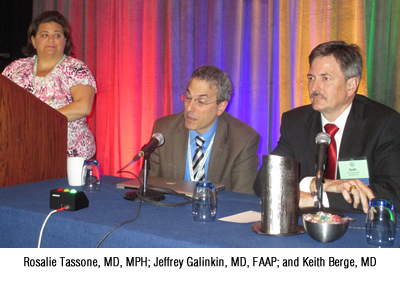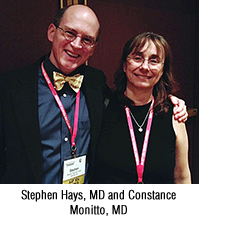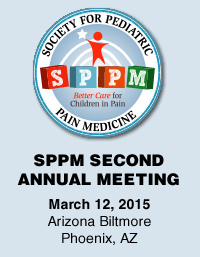Society for Pediatric Pain Medicine (SPPM)
First Annual Meeting 2014 Review
By Sophie R. Pestieau, MD
Children's National Health Systems, Washington. DC
The Society for Pediatric Pain Medicine held their 1st Annual Meeting in Fort Lauderdale, FL. This inaugural meeting took place on Thursday, March 6, 2014 immediately prior to the SPA/AAP Pediatric Anesthesiology 2014 meeting, March 7-9, 2014. The SPPM meeting featured four plenary sessions, a round table discussion and PBLDs at lunch, as well as workshops to wrap up the day. It was a pleasure to be in a sunny, warm locale, especially for many of the northeasterners who had battled an unusually harsh and cold winter.
 The opening words and an outline of the educational program were offered by the meeting’s Program Chair, Petra Meier-Haran, MD, DEAA (Boston Children's Hospital) and the SPPM’s President, Sabine Kost-Byerly, MD, FAAP (Johns Hopkins), who also moderated the first session on the developmental aspects of pain. Our keynote speaker, Maria Fitzgerald, BA, PhD, FMedSci (University College London), an international expert on the pediatric neurobiological development of pain pathways, gave us a short and long-term view of pain in infancy and childhood. She helped us understand that pain pathways undergo developmental changes over infancy and childhood that will impact pain sensitivity and pain treatment. There are important differences in acute pain processing with age and appreciating these variations can lead to improved treatment in the future.
The opening words and an outline of the educational program were offered by the meeting’s Program Chair, Petra Meier-Haran, MD, DEAA (Boston Children's Hospital) and the SPPM’s President, Sabine Kost-Byerly, MD, FAAP (Johns Hopkins), who also moderated the first session on the developmental aspects of pain. Our keynote speaker, Maria Fitzgerald, BA, PhD, FMedSci (University College London), an international expert on the pediatric neurobiological development of pain pathways, gave us a short and long-term view of pain in infancy and childhood. She helped us understand that pain pathways undergo developmental changes over infancy and childhood that will impact pain sensitivity and pain treatment. There are important differences in acute pain processing with age and appreciating these variations can lead to improved treatment in the future.
In addition, she described how nerve injury and tissue inflammation in early life can have long term consequences upon pain processing later in life. Animal studies reveal that exposure to untreated pain and stress may “prime” the system so that subsequent injury later in life can be more significant. Infants do not seem to get neuropathic pain and persistent and chronic pain syndromes rarely occur in children younger than four year old. This is also true in young rodents, where nerve injury does not trigger neuropathic pain-like behaviors, but these animals can, however, have increased hypersensitivity with the onset of adolescence. Dr. Fitzgerald concluded her talk by discussing the use of sucrose which has been used for “analgesia” in young infants and animals. However, despite behavioral changes and decreased outward signs of pain or stress, there seem to be no EEG or EMG changes indicative of analgesia. Furthermore, studies have shown that animals would rather eat than react to pain. Perhaps we are the same as hedonistic eaters!
The session continued with a review of the essentials of developmental pharmacokinetics/pharmacodynamics and side effects of commonly used opioids in infants and young children by Anne Lynn, MD (Seattle Children’s Hospital). While reviewing the data of several studies she also presented her clinical approach of titrating opioid doses such as morphine and fentanyl in infants. She highlighted that opioid dosing in infants is difficult as it does not follow clearance maturation and that there is a 2-3 fold variability in clearance. There is also variability in dosing with increasing age and due to ethnic, gender and genetic factors. An interesting review of kinetic studies of ketorolac in infants and children by Dr. Lynn noted that in the 2-6 month and 6-18 month age range, infants given a single dose of ketorolac following surgery, showed a more rapid clearance of the S-isomer as compared to the R-isomer, without renal or hepatic dysfunction or increase in surgical drain output. As a result of these findings, it is unclear whether the S-isomer would perhaps be safer for repeated doses in infants. Following Dr. Lynn’s talk, we had an interactive panel discussion with the speakers, led by the session’s moderator Dr. Kost-Byerly.
After a short break, our next moderator, Robert Wilder, MD, PhD (Mayo Clinic, Rochester) led us into Session 2: “What’s New in Regional Anesthesia?” Arjunan Ganesh, MBBS (Children’s Hospital of Philadelphia) discussed the indications for children being sent home with regional catheters and continuous perineural infusions (CPNI), the development of an ambulatory CPNI program, and the management of most common problems. The result of Dr. Ganesh and his team’s experience with 1492 catheters in 1285 patients at CHOP is summarized in the March edition of Anesthesia & Analgesia. Dr. Ganesh finished by giving us some insight on what the future holds for regional anesthesia with the potential impact of telemedicine to monitor patients with CPNI at home and the up and coming, long-acting local anesthetics.
David Polaner, MD, FAAP (Children’s Hospital of Colorado) followed by discussing best practice and avoidance of most common adverse events in regional anesthesia. Although there is an increasing amount of prospective data (like PRAN), complications in pediatric regional anesthesia are rare and the “n” is still insufficient to know about all rare events. Regarding practices to prevent adverse events, Dr. Polaner highlighted that imaging may not only increase block safety and efficacy, but also permit reduced drug volumes for peripheral nerve blocks. Test dosing remains effective in detecting accidental intravascular injection. Finally, amongst other strategies for mitigating errors and improving quality and outcomes, he concluded by questioning whether checklists are the answer, and discussing the potential role of a “Regional Anesthesia Time-Out Checklist”.
Constance Houck, MD (Boston Children's Hospital) ended this session with a review of pain management for minimally invasive procedures and effective techniques to reduce shoulder and diffuse abdominal pain. She also reviewed modalities to facilitate earlier hospital discharge. In doing so, Dr. Houck emphasized that although epidurals remain the gold standard for thoracotomies, there are in fact other modalities available for video-assisted thoracoscopic surgery (VATS). Peripheral nerve blocks, for example, such as paravertebral blocks not only provide adequate analgesia for VATS but also less nausea, vomiting and urinary retention when compared to epidurals and is the preferred technique in the UK. On the other hand, intercostal blocks require multiple injections at multiple levels increasing the risk of pneumothorax. In addition, intrapleural injections often lead to loss of local anesthetic solution via the chest tubes and carry an increased risk of local anesthetic toxicity. Another interesting concept was the injection of the periphrenic fat pad to prevent ipsilateral referred shoulder pain. The second portion of Dr. Houck’s talk focused on the sources of pain after laparoscopic surgery, incisional vs. diffuse abdominal pain vs. shoulder pain, and the options for preventive therapies such as the intraperitoneal aerosolization of local anesthetics.
At noon the attendees had a choice of attending either a round table discussion with our international keynote speaker Dr. Maria Fitzgerald, or one of nine PBLDs with the meeting faculty.
Our third session titled “Pain Management is About Risk Management” was moderated by Rosalie Tassone, MD, MPH (University of Illinois). Jeffrey Galinkin, MD, FAAP (Children’s Hospital of Colorado) addressed some of the current controversies of prescription drug abuse, abuse patterns, and risk assessment in teenagers. He pointed out the recent spike in the way opioids are prescribed in the US. Although the US represents just under 5% of the world’s population, in 2007 we consumed 83% of the world’s oxycodone and 99% of the world’s hydrocodone. Similarly, in recent years, vicodin, codeine, percocet and oxycontin have gained prevalence amongst school aged children in grades 8-12 primarily due to the misconception that “since it is a prescription drug it is safer than illicit drugs” and “since it was prescribed to me I can use more if I need it”.

Noting this rise in prescription opioid drug abuse, Dr. Galinkin concluded that as physicians, parents and individuals, we should always keep a high index of suspicion and apply common sense to decrease risk. Keith Berge, MD (Mayo Clinic, Rochester) followed by discussing diversion in patients and staff and how as the prescribing physician we can decrease the odds for such an epidemic. In addition, he reviewed the FDA’s Risk Evaluation and Mitigation Strategy (REMS) to ensure that the benefits of extended release and long acting opioid analgesics outweigh the risks, and in particular our role as prescribers to assess each patient’s risk for abuse.
 Following this rather distressing topic, Rita Agarwal, MD, FAAP (Children’s Hospital of Colorado) moderated the last session of the day, the highly anticipated pro-con debate. The two creative, entertaining, and expert panel members were Stephen Hays, MD, FAAP (Vanderbilt, Nashville) and Constance Monitto, MD (Johns Hopkins) who for 15 minutes each, debated on peripheral vs. central blocks, while reviewing the historical development, current indications and contraindications, and potential complications in pediatric perioperative pain management. In a very animated and light-hearted way, Stephen Hays outlined his top 10 reasons why peripheral nerve blocks should be favored OVER central blocks. Constance Monitto, responded by explaining why central blocks might be favored for bilateral and truncal surgeries, while acknowledging that peripheral nerve blocks have a significant role to play and are getting more commonplace in our practice, especially for one-sided surgeries. Dr. Hays proceeded to his rebuttal, followed by questions to the two panelists with the conclusion that one still needs to weigh the risk benefit ratio of the regional technique chosen.
Following this rather distressing topic, Rita Agarwal, MD, FAAP (Children’s Hospital of Colorado) moderated the last session of the day, the highly anticipated pro-con debate. The two creative, entertaining, and expert panel members were Stephen Hays, MD, FAAP (Vanderbilt, Nashville) and Constance Monitto, MD (Johns Hopkins) who for 15 minutes each, debated on peripheral vs. central blocks, while reviewing the historical development, current indications and contraindications, and potential complications in pediatric perioperative pain management. In a very animated and light-hearted way, Stephen Hays outlined his top 10 reasons why peripheral nerve blocks should be favored OVER central blocks. Constance Monitto, responded by explaining why central blocks might be favored for bilateral and truncal surgeries, while acknowledging that peripheral nerve blocks have a significant role to play and are getting more commonplace in our practice, especially for one-sided surgeries. Dr. Hays proceeded to his rebuttal, followed by questions to the two panelists with the conclusion that one still needs to weigh the risk benefit ratio of the regional technique chosen.
Following the last plenary session, attendees had the opportunity to attend a SPPM workshop on the basics of establishing a pediatric pain program. Dr. Kost-Byerly, Giovanni Cucciaro, MD, MPP (Children’s Hospital Los Angeles) and Alexandra Szabova, MD (Cincinnati Children's Hospital) presented an inter-institutional perspective on “Developing a Pediatric Pain Program,” with the goal being to help define the institutional needs and potential stakeholders, appropriate staffing, clinical care solutions, and identifying components of a successful program. In addition to this SPPM workshop, the SPA offered two additional workshops: an “Acupuncture Pain Management” workshop and an “Advanced Ultrasound Guided Regional Anesthesia” workshop.
And so ended our first meeting and decidedly educational day! Enjoy the summer and we look forward to meeting again this fall in New Orleans, LA for the SPA 28th Annual Meeting and of course next year, for the 2nd SPPM Annual Meeting to be held on March 12, 2015 in Phoenix, AZ.

